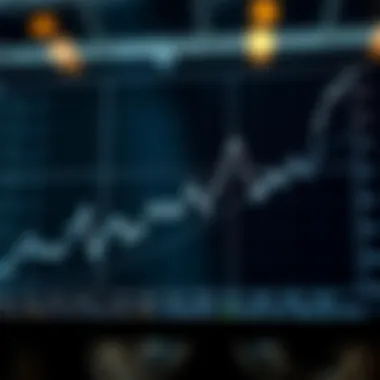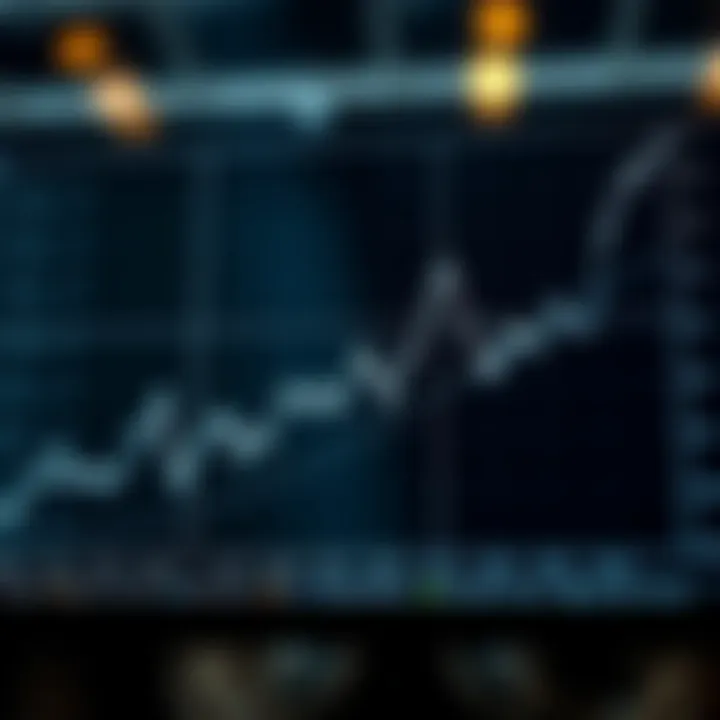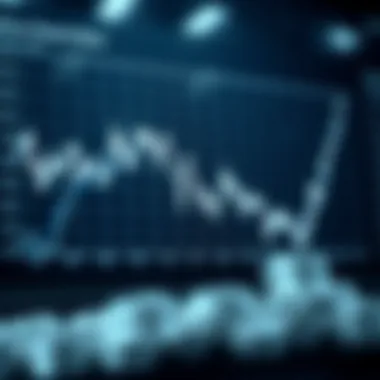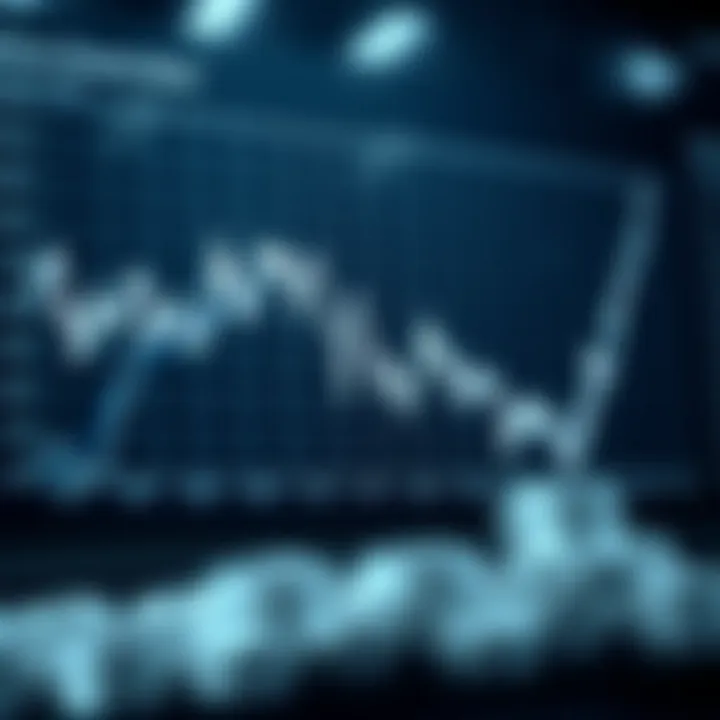Understanding Current Trends in NYSE Silver Prices


Intro
Navigating the world of silver trading on the New York Stock Exchange (NYSE) can often feel like embarking on a rocky sea. With prices fluctuating as unpredictably as tides, understanding the factors at play can be the difference between riding the wave of profit or being swept away by sudden dips.
In this exploration of silver prices, we will break down complex terminology, investigate market trends, and showcase expert insights that inform savvy investment strategies. This article aims to equip both novice and seasoned investors with the tools necessary to interpret the landscape of silver trading effectively.
Key Definitions
Essential Financial Terms
When it comes to silver trading, several terms frequently surface, and knowing them is pivotal for any investor. Here are some essential definitions:
- Spot Price: This is the current market price at which silver can be bought or sold for immediate delivery. It often shifts hour by hour based on market demand and supply.
- Futures Contract: A legal agreement to buy or sell silver at a predetermined price at a specified time in the future. These contracts are often used by investors to hedge against price fluctuations.
- Bull Market: A period during which the prices of silver are rising, encouraging investors to buy in anticipation of even higher prices.
- Bear Market: Conversely, this is a period characterized by declining prices, often causing traders to sell off their investments.
Terminology Breakdown
Understanding the framework of silver investment isn't merely about memorizing terms. It's about grasping how they interplay within the market.
- Volatility: This refers to the extent of price variation over time. Silver prices can be quite volatile, influenced by macroeconomic factors, geopolitical tensions, and changes in investor sentiment.
- Liquidity: This denotes how quickly and easily silver can be bought or sold in the market without affecting its price significantly. A high liquidity means finding buyers and sellers is easier.
- Correlation: Understanding how silver prices move with or against other assets, like gold or oil, can provide additional context for investment decisions.
Expert Insights
Investment Strategies Explained
Investing in silver can vary greatly depending on individual strategies and market conditions. Here are some popular approaches that seasoned investors typically adopt:
- Buy and Hold: This long-term strategy involves purchasing silver and holding onto it through ups and downs to benefit from potential price increases over time.
- Trading Silver ETFs: For those who prefer not to hold physical silver, Exchange-Traded Funds (ETFs) that track silver can be a viable option, offering ease of transaction and lower storage costs.
- Diversification: Spreading investments across various asset classes, including silver, can minimize risk. A well-balanced portfolio might include stocks, bonds, and commodities like silver.
Market Trends and Analysis
Silver prices don’t exist in a vacuum; they are impacted by a multitude of factors. Some current trends influencing the market include:
- Industrial Demand: Silver is used in electronics, solar panels, and various technologies. A surge in industrial activity can increase demand, pushing up prices.
- Geopolitical Tensions: Global events often spark interest in precious metals. When uncertainty looms, investors may flock to silver as a safe haven.
- Monetary Policy: Decisions made by central banks regarding interest rates can influence silver prices. For instance, low interest rates typically lead to higher silver prices as the opportunity cost of holding non-interest-bearing assets diminishes.
"Understanding these dynamics is crucial for anyone looking to invest wisely in silver. The market is rarely straightforward, and being well-informed is your best defense against volatility."
Understanding NYSE Silver Pricing
Grasping the nuances of silver pricing on the New York Stock Exchange (NYSE) is paramount for anyone looking to navigate the world of precious metals investment. Silver, often deemed as a "poor man's gold," holds its own complexities and benefits that require astute consideration. Understanding these dynamics helps investors make more informed decisions, ultimately influencing their investment success. The NYSE serves as a significant marketplace for silver, and this section will explore the multiple layers associated with this topic.
The Role of the NYSE in Precious Metals Trading
The New York Stock Exchange plays a crucial role in the trading of precious metals, including silver. It functions as a regulated marketplace where prices can reflect supply and demand dynamics transparently.
Silver trading on the NYSE leverages the platform's liquidity, allowing investors to buy and sell with relative ease compared to other markets. But it's not just about ease of transaction; the integrity and transparency of the NYSE are vital. Investors can trust that prices are determined by real-time trading activity and comprehensive market data.
Moreover, the NYSE's establishment of strict regulations contributes to the security of transactions. This results in minimal chances of market manipulation, providing a safer environment for investors to engage in. By operating on a global scale, the NYSE also allows U.S. investors to tap into international demand for silver, making them part of a broader trading ecosystem.
How Silver is Traded on the NYSE
Silver on the NYSE can be traded in several forms, each catering to different investor needs and strategies. Primarily, it is traded through silver futures contracts and Exchange-Traded Funds (ETFs) that focus on silver.
- Silver Futures: These contracts obligate the buyer to purchase, and the seller to sell a specific amount of silver at a predetermined price and date. Futures trading can be a double-edged sword, as it magnifies profits but equally amplifies risks. Traders need to have their wits about them, as price fluctuations can occur in the blink of an eye.
- Silver ETFs: Exchange-Traded Funds are perhaps the most accessible way for casual investors to gain exposure to silver without having to deal with physical silver’s storage and insurance issues. ETFs track the price of silver and are designed to reflect its movements closely. They offer a level of simplicity and liquidity that appeals to many. However, investors must also factor in the management fees that come along with these funds.
Investing in silver through the NYSE offers a flexible portfolio strategy, allowing investors to adjust to market conditions as they see fit.
In summary, understanding NYSE silver pricing means becoming familiar with how this metal trades, the varying forms of investment available, and the inherent risks and rewards. By delving into these aspects, investors can better position themselves to make informed, strategic decisions in the silver market.
Current Trends in Silver Pricing
Understanding the current trends in silver pricing is crucial for both budding investors and financial whizzes. The NYSE is a great bellwether for uncovering the shifts in silver’s value, revealing much about its trajectory in the broader market landscape. Silver’s allure goes beyond being a mere asset; it is a strategic choice for many that intertwines with economic currents, investor psychology, and industrial demand. Being aware of these trends can help investors navigate volatility and maximize potential returns.
Recent Price Movements
The silver market has seen quite a roller-coaster ride lately. Prices have fluctuated significantly, reflecting broader market sentiments and sentiments. For instance, in recent months, silver prices soared to approximately $28 an ounce, then dipped below $24 amidst shifting economic indicators. Such movements often attract savvy investors looking to capitalize on short-term opportunities, while long-term holders may view these fluctuations as potential buying opportunities.
This kind of price volatility can often be tied back to larger global events — economic indicators from China, trade negotiations between the US and other countries, or even speculation spurred by social media. Understanding these price movements can give investors a clearer picture of when to engage the market and at what levels.
Influencing Factors


Global Economic Conditions
The link between silver pricing and global economic conditions cannot be understated. When economies flounder or exhibit recessionary signs, precious metals like silver often become a safe haven for many investors. Amid economic turbulence, there’s a tendency for investors to backtrack from volatile markets and seek refuge in tangible assets. This behavior reinforces silver's role as a protective asset during uncertain times, reflecting its intrinsic value and historical significance.
Moreover, reliance on global supply chains can affect silver prices too. If a major producer like Peru faces political instability, it may disrupt silver production and consequently, prices may rise due to scarcity. Keeping an eye on such conditions is critical for investors aiming to engage with the market at the right moments.
Inflation and Currency Strength
A pertinent aspect of inflation and currency strength is their synergistic relationship with silver pricing. When inflation creeps up, the purchasing power of currency often decreases, leading people to seek out solid assets like silver. In other words, inflation may drive investors to silver to hedge against the devaluation of their money. In turn, this can create a ripple effect where demand for silver increases, causing prices to rise as well.
For example, when the US dollar weakens due to inflationary pressures, silver becomes relatively more attractive to both local and international investors. The dollar's depreciation makes for a unique advantage since silver prices in US dollars may rise relative to other currencies. Understanding these dynamics can equip investors with insights for better timing of their investments.
Changes in Industrial Demand
Lastly, the changes in industrial demand play a significant role in shaping silver prices. Silver isn't just a shiny investment — it’s also used extensively in industries like electronics, solar energy, and medical applications. For instance, the rise in demand for solar panels, especially with the global push for renewable energy, contributes to a swell in silver utilization, leading to increased prices.
When industries that consume silver grow or contract, they can impact pricing directly. This interplay of supply and demand underscores the importance of staying informed about trends within relevant sectors, as shifts in industrial needs can act as signals for anticipating the direction of silver pricing.
Understanding these influencing factors is not just beneficial; it's essential for any investor keen on staying ahead of the game.
By grasping the current trends and recognizing their root causes, investors can better position themselves to tackle the challenges and rewards that come with silver trading on the NYSE.
Investment Strategies for Silver
Investing in silver can be a daunting task, particularly with the current market dynamics on the NYSE. However, having a clear investment strategy is crucial for navigating this complex landscape. For both new and seasoned investors, understanding the various approaches to engage with silver can have a significant impact on overall portfolio performance. Key strategies range from long-term holding of physical silver to trading financial instruments like ETFs, each presenting unique benefits and considerations.
Long-term Holding vs. Short-term Trading
When deciding between long-term holding and short-term trading, investors should first consider their personal financial objectives and risk appetite. Long-term holding typically involves purchasing silver with the intention of keeping it for an extended period—often years—aiming for capital appreciation over time. This strategy is attractive due to its potential for significant gains, particularly if silver prices soar due to economic uncertainty.
On the other hand, short-term trading focuses on taking advantage of market volatility and price fluctuations. Investors who opt for this approach need to be quick on their feet, making timely decisions based on market indicators. This can be a double-edged sword; while the potential for quick gains exists, so does the risk of losses. It's vital for short-term traders to employ strong analytical skills and perhaps even technical analysis to guide their trades.
In summary, investors should weigh the pros and cons of both strategies based on their risk tolerance and investment goals. Some may find a hybrid approach, combining both long-term holdings and short-term trades, provides the best of both worlds.
Using Silver ETFs as Investment Vehicles
Exchange Traded Funds (ETFs) that focus on silver are often viewed as accessible means for investors to gain exposure without needing to physically own the metal. They offer benefits like liquidity and ease of trading, making them appealing options for a wide variety of investors.
Types of Silver ETFs
There are primarily two types of silver ETFs: those that hold physical silver and those that invest in silver mining companies. The former directly tracks the price of silver, giving a clear reflection of market movements. It is an excellent choice for those wanting a straightforward investment strategy without dealing with the complexities of physical storage. Alternatively, ETFs that invest in mining firms can provide leveraged exposure to silver prices; however, this strategy introduces additional operational risks associated with the mining sector.
This variety ensures that investors can choose according to their preference and risk profile. Additionally, diversification across these ETF types can cement your investment in the silver market while mitigating some specific risks associated with individual assets.
Advantages and Disadvantages
While investing in silver ETFs is viewed as a favorable approach, it is crucial to analyze the advantages and disadvantages. A significant advantage is the lower cost of entry compared to buying physical silver. Additionally, they offer investor protection from certain risks, as most reputable ETFs are backed by tangible silver or verifiable shares of mining companies.
On the flip side, potential disadvantages may include management fees and market risk. Investors may also lack the tangible ownership—you don’t physically possess the silver, which can be a consideration for those who value having the actual asset. Moreover, during periods of extreme market volatility, ETFs can experience price discrepancies compared to the underlying asset due to market supply and demand dynamics.
In summary, understanding the types of silver ETFs and their advantages and disadvantages can significantly enhance your investment strategy. Investments must align with your broader financial goals and provide a balanced approach to risk and return.
“Investing in silver requires both careful consideration and a strategic plan. It’s not just about the metal; it’s about understanding your options and making educated choices.”
Analyzing Historical Silver Prices
Understanding the dynamics of historical silver prices is not just about looking at numbers from the past; it’s about grasping the narrative those numbers tell. Just like a seasoned detective pieces together evidence, investors can reap insights from historical price trends, equipping themselves with knowledge to navigate today’s market. Trends in silver prices provide a backdrop against which current fluctuations can be interpreted. This section delves into the significance of analyzing these trends as a tool for both novice and experienced investors alike, illuminating not only patterns but the strategic considerations that help shape investment decisions.
Key Historical Price Trends
Historically, the price of silver has displayed some remarkably telling trends. Consider this: back in the 1970s, silver prices soared from just a few dollars to almost $50 an ounce in 1980. This seismic shift was largely influenced by the Hunt brothers’ attempt to corner the silver market. Fast forward to the early 2000s, silver remained relatively stable before starting a gradual ascent towards its peak in recent years.
- 1970s Boom: The dramatic increase in value during this decade illustrated the sheer volatility that silver can experience based on market manipulation and speculation.
- 2000-2010 Stability: For much of this decade, prices hovered around $15 to $20. Investors tended to regard silver as a safe haven, a strategic play in times of economic uncertainty.
- Recent Trends: The past few years have shown increased demand driven by technological applications, especially with the rise of green energy initiatives. This backdrop of shifting demand paradigms hints at how technological advancements can impact pricing strategies moving forward.
Pricing trends manifest the duality of silver as both an industrial metal and an investment commodity. As one evaluates these patterns, it becomes clear that external factors—like inflationary pressures or geopolitical tensions—ripple through itself atypical sometimes.
Lessons from Past Market Conditions
Past market conditions provide a wealth of insights worth pondering. One such lesson is that silver often behaves inversely to the broader stock market dynamics. When stock markets waver, silver can act as a counterbalance, a refuge for nervous investors.
- Crisis Catalysts: Events such as the 2008 financial crisis reshaped investor perceptions. Many turned to silver as a trustable asset when stocks fell off a cliff. The subsequent price rally solidified silver’s role as a hedge against market collapse.
- Market Sentiment: Investor sentiment often morphs based on historical context; if you look back, a pattern emerges whereby prolonged periods of low prices tend to precede sudden spikes when investors finally realize the potential value aspects.
- Supply and Demand Dynamics: Industrial demand influences silver prices significantly. The transition to electric vehicles and renewable energy sources serves to illustrate how modern advancements can shift price paradigms drastically; investors who closely monitor these industrial trends can often anticipate changes.


In summary, reflecting on historical silver price trends is akin to using a roadmap for future journeys. By learning from past market conditions, investors can strategically position themselves to leverage opportunities or guard against potential pitfalls. Mastering these lessons is a critical element of making informed investment decisions.
Expert Insights on Silver Investments
Understanding the perspectives from industry experts is crucial for anyone looking to navigate the complexities of silver investments. These insights can provide a clearer picture of market trends and potential opportunities. Grasping expert opinions offers investors not only a strategic edge but also reassurance during volatile times in the market.
In this section, we dive into the various dimensions of market sentiment surrounding silver, followed by forward-looking predictions. This information is especially useful for those who are keen on making informed decisions based on nuanced analysis rather than mere speculation.
Bulls vs. Bears: Market Sentiment
Market sentiment reflects the general attitude of investors towards silver, often categorized into two camps: bulls and bears. The bulls are optimistic, believing that silver prices will rise due to factors such as increasing demand or supply constraints. On the flip side, bears anticipate a decline, perhaps due to a strong U.S. dollar or reduced industrial use of silver.
Understanding these sentiments can help investors gauge the market's mood. For instance, if many analysts bullishly predict that prices will rise due to upcoming industrial applications of silver in technology, it might signal to investors that now could be the time to buy. Conversely, widespread bearish sentiment might suggest caution, as falling prices could lead to short-term losses.
Ultimately, whether one leans toward optimism or pessimism, it's essential to keep an ear to the ground and evaluate how larger economic indicators play into market mood.
Forecasting Future Price Movements
Analyst Predictions
Analyst predictions are a cornerstone of understanding potential price trajectories in the silver market. These predictions are often backed by thorough research and analysis, and they can significantly influence investor behavior. By paying attention to these forecasts, investors can gain insights into potential market trends and make more informed decisions.
One of the characteristics of analyst predictions is that they often employ data modeling, historical performance, and current economic indicators to formulate their outlooks. These factors make analyst predictions a popular choice for investors who want more than just gut feelings or hearsay.
However, while these predictions can be beneficial, they aren't infallible. Market conditions can shift rapidly, and external factors can disrupt well-laid forecasts, making it essential to treat these insights as part of a broader strategy rather than the sole basis for investment decisions.
Potential Economic Scenarios
When it comes to potential economic scenarios, the focus is on various future outcomes that could influence silver prices. This aspect is crucial as it helps investors prepare for different circumstances, ranging from high inflation rates to potential recessions.
The unique characteristic of considering potential economic scenarios is that it enables a more adaptable investment strategy. For example, if analysts predict an economic downturn, it may prompt investors to liquidate some silver holdings to avoid losses. Alternatively, if positive growth is forecasted, investors might look to increase their investments.
These scenarios also come with advantages and disadvantages. On the one hand, they provide valuable foresight, which is always beneficial in making informed choices. On the other hand, the unpredictability of economic factors can sometimes render these predictions moot, leading to strategic missteps if investors react too strongly to hypothetical scenarios.
Practical Considerations for Silver Investors
Investing in silver on the NYSE provides not only the potential for financial reward but also considerable inherent risks. Understanding these facets is crucial for making informed decisions. Practical considerations can be a guiding light for both novice and seasoned investors. This section delves into two vital aspects: assessing risk tolerance and diversifying within precious metals. By grasping these concepts, investors can create more resilient portfolios against the volatile nature of the silver market.
Assessing Risk Tolerance
Understanding one’s risk tolerance is foundational in the realm of investing. Each investor's capacity to take on risk varies widely, and knowing where you fit on that spectrum can save considerable heartache down the line. This isn't just a matter of personality; various factors like age, income, and financial goals play into it as well.
- Age: Younger investors might be more willing to take risks than those closer to retirement. The ability to recover from losses is a key consideration.
- Financial Situation: Those with a steady income might feel comfortable engaging in high-risk trades compared to someone who relies heavily on their investment returns for living expenses.
- Investment Goals: If your objective is wealth accumulation over decades, a slightly higher risk might be justifiable as opposed to someone looking for short-term gains.
Taking the time to self-evaluate can lead to better investment choices. For example, an investor with a low risk tolerance might prefer silver ETFs that have stable growth, while others may choose to buy physical silver, which might fluctuate more but could offer a different type of security.
Diversifying within Precious Metals
Diversification is a buzzword thrown around frequently in investing circles but for good reason. In the precious metals sector, it’s especially important to balance your holdings not just in silver, but also across other precious metals like gold, platinum, and even palladium. Each metal features its own market dynamics and can react differently to economic changes.
Investing in multiple types of precious metals can provide a buffer against market fluctuations. For instance:
- Gold: Often seen as a safe haven during economic downturns.
- Platinum: Has industrial demand that occasionally outstrips silver during boom times.
- Palladium: Recently gained popularity due to its role in the automotive industry, particularly for catalytic converters.
Furthermore, the volatility of silver can sometimes be mitigated by increases in the value of gold or platinum. An insightful investor analyzes how each metal interacts with the market cycle and uses this information to guide investment decisions.
Therefore, combining various precious metals into your investment portfolio may lead to a more balanced approach, providing both growth potential and a safety net in uncertain times.
"Diversity in investments isn’t just smart; it’s survival."
Regulatory Framework Affecting Silver Trading
Navigating the world of silver investments requires more than just an understanding of market dynamics and potential trends. It’s essential to have a firm grasp on the regulatory framework that governs the trading of silver on the NYSE. Regulations play a pivotal role in ensuring market integrity, transparency, and investor protection. In this context, we delve into specific elements of regulations that affect silver trading, the benefits they bring, and crucial considerations investors must keep in mind.
Understanding Market Regulations
Market regulations are crafted to oversee the buying and selling of silver, which includes regulations established by government entities like the Securities and Exchange Commission (SEC) and other regulatory bodies. These regulations often encompass:
- Disclosure Requirements: Companies involved in silver trading are obligated to provide transparent information, helping investors make well-informed decisions. This includes financial reporting and compliance with various accounting standards.
- Anti-fraud Measures: Regulations are in place to deter fraudulent activities. For example, insider trading laws are strictly enforced to maintain fair practices.
- Trading Standards: These are mandatory criteria that trading platforms must adhere to. They ensure that trades are executed smoothly and efficiently, even when the market becomes volatile.


Understanding these regulations not only helps in fostering confidence among investors but also aids in creating a more stable trading environment for silver.
Tax Implications for Silver Investments
Investing in silver doesn’t just stop at buying the metal or shares of silver ETFs; it also comes with its share of tax implications. Understanding these implications is vital for any investor seeking to build wealth through silver.
- Capital Gains Tax: When you sell your silver investment, any profit you make may be subject to capital gains tax. It’s important to be aware of the specific rates that apply, as they can vary significantly based on how long you held the investment.
- Collectibles Tax Rate: Silver coins and metals fall under the collectibles category with a higher tax rate—28% as opposed to the typical 15% for standard long-term capital gains. Knowing this can heavily influence investment decisions.
- State Taxes: Depending on where you live, you may also be subject to state taxes on your silver transactions. Some states might exempt precious metals, while others might impose various levies.
- Reporting Obligations: Investors must also be cognizant of their reporting obligations related to silver assets. This includes the need to report trades and any earnings accrued from them during tax season.
Understanding the tax implications helps investors in not just fostering profits but also in strategizing their silver investments effectively to align with their overall financial plans.
"Navigating the regulations and tax landscape is akin to charting a course through uncharted waters; it’s vital to know your navigation tools well."
In summary, the regulatory framework surrounding the trading of silver on the NYSE is a complex matrix that governs various facets of the investment landscape. By staying informed about market regulations and associated tax obligations, investors can safeguard their investments and enhance their strategic approach to silver investment.
Technological Impacts on Silver Pricing
In today's rapidly evolving financial landscape, it is imperative to understand how technology is reshaping the ways we trade and value silver on the New York Stock Exchange. Technology is not just a tool; it acts as a catalyst that influences pricing dynamics, trading behaviors, and investor strategies. The significance of these technological advancements permeates through various arenas including trading mechanics, market accessibility, and transaction efficiency. Understanding these impacts can give investors an edge in navigating the complexities of silver investments.
The Role of Algorithms and Trading Platforms
Algorithms are often viewed as the backbone of modern trading platforms. They process vast amounts of data at lightning speed, allowing traders to make decisions based on real-time information. For silver prices, this means that algorithms can analyze factors such as global economic indicators, market sentiment, and price movements almost instantaneously, providing traders with timely insights.
- High-Frequency Trading (HFT): These algorithms enable high-frequency trading which can amplify price movements. A minor shift in trading activity may cause silver prices to fluctuate significantly within short periods.
- Automated Trading Strategies: Many investors deploy automated strategies using algorithms designed to buy or sell silver at predetermined price points. This takes emotional decision-making out of the equation and improves objectivity.
- Market Analytics: Trading platforms equipped with AI can generate predictive models based on historical and real-time data. This can help investors forecast potential market movements and make informed decisions about their silver investments.
Moreover, platforms like Robinhood and E*TRADE have democratized access to silver trading. They empower both novice and seasoned investors to engage without hefty fees, leveling the playing field.
Blockchain and Precious Metals
Blockchain technology is another significant influence in the silver trading sphere. Having its roots in cryptocurrency, blockchain is being integrated into commodities trading systems to enhance transparency and security. The implications for silver prices are profound.
- Traceability of Silver: Blockchain allows for the tracking of silver from the mine to the market. This not only assures authenticity but also fosters trust among investors. Individuals can verify the provenance of their investments which is critical in a market susceptible to fraud.
- Smart Contracts: These are self-executing contracts with the terms of the agreement directly written into code. Smart contracts can automate transactions, reduce costs, and ensure compliance with regulations, streamlining the buying or selling processes of silver.
- Market Efficiency: With blockchain, transactions can occur in real-time without the need for intermediaries. This can reduce overall transaction times and influence pricing strategies due to lower execution costs.
Blockchain represents a paradigm shift in how silver and other commodities can be traded, potentially increasing efficiency and trust, both crucial for pricing integrity.
Comparative Analysis: Silver vs. Other Precious Metals
The price dynamics of silver on the NYSE is intricately tied to its performance relative to other precious metals like gold, platinum, and palladium. Understanding these relationships is crucial for investors. By comparing silver with its counterparts, one can better interpret market movements, highlight investment opportunities, and make informed decisions. This section sheds light on the nuances of these comparisons, facilitating investor confidence.
Gold versus Silver: A Comparative Study
Gold is often seen as the king of precious metals, renowned for its stability during economic uncertainty. However, silver presents a compelling case, especially for those seeking affordability and versatility. When pitting gold against silver, the following factors come into play:
- Historical Performance: Gold has historically outperformed silver during economic crises, underscoring its role as a safe haven. Yet, silver has shown remarkable spikes during periods of inflation or when industrial demand surges.
- Investment Demand vs. Industrial Demand: Gold's value is largely derived from investment demand, while silver finds itself straddling both investment and industrial sectors. This dual demand can lead to more volatile price movements for silver.
- Price Ratio: The gold-to-silver ratio often serves as a compass for investors. When this ratio favors silver, it indicates good buying opportunities for those looking to capitalize on potential price corrections.
Comprehensively analyzing these aspects allows investors to perceive silver not merely as a secondary choice but as an integral part of their precious metals portfolio.
Platinum and Palladium: Investment Opportunities
Platinum and palladium have gained traction in recent years, especially given their applications in automotive catalytic converters and electronics. When comparing these metals with silver, investors should consider:
- Market Dynamics: Platinum often displays a higher value due to its scarcity and complicated extraction processes. In contrast, silver, being more abundant, provides a different risk and reward profile.
- Price Volatility: Palladium has seen staggering price leaps, prompted by demand surges. While silver can be volatile, palladium's recent spikes present unique investment opportunities that carry high potential rewards—and risks.
- Diversification Benefits: Holding a mix of silver, platinum, and palladium can mitigate risks associated with relying on a single metal. Each of these metals behaves differently in the market, providing investors with opportunities to hedge their positions.
This comparative analysis not only clarifies the unique characteristics of silver in relation to its precious metal peers but also emphasizes the importance of a holistic investment strategy. Diversifying among silver, gold, platinum, and palladium can enhance resilience against market fluctuations and tap into the various opportunities these metals present.
For further reading, you can explore resources from Britannica and Wikipedia on these topics.
Closure: The Future of Silver Trading
As we cast our gaze towards the horizon of silver trading on the NYSE, its future undoubtedly appears to be shaped by a multitude of forces. This section of the article is vital as it not only summarizes the previous discussions but also sets the stage for what investors can expect moving forward. Given the volatile nature of silver prices, understanding market conditions, economic factors, and shifting demand patterns will empower investors—both rookies and seasoned veterans—to make informed decisions.
Market Resilience and Adaptability
The silver market has shown a certain tenacity over the years, bouncing back from dips and re-establishing itself amid broader economic fluctuations. This resilience is rooted in silver's dual role as both an industrial metal and a store of value. Even in challenging times, such as periods of economic downturn or inflated currency rates, silver often finds a way to capture investor interest.
A few points to ponder:
- Historical Trust: Silver has been viewed as a safe haven for centuries, many investors still lean toward it during turbulent times. This historical trust helps maintain its desirability.
- Industrial Demand: Industries utilizing silver—such as electronics, solar energy, and medical applications—are fundamentally supportive of its demand. As technology continues to evolve, the appetite for silver remains strong.
- Market Adaptations: With advances in trading technology and varying market dynamics, traders now have tools to navigate the complexities of the silver market more adeptly. From algorithmic trading to blockchain verification, the future of trading silver is adapting rapidly.
In short, the adaptable nature of the silver market positions it uniquely among other commodities, and monitoring these nuances is essential for any investor looking to thrive in the changing landscape.
Investment Outlook for New Entrants
For those considering entering the silver market, it is crucial to analyze the environment before taking the plunge. The insights gained from historical price movements, current trends, and expert opinions create a solid foundation for decision-making. Here are some key considerations:
- Entry Points: Timing is everything. Investors should look for favorable price levels, particularly during dips when silver may be undervalued.
- Diversification Strategy: New investors should consider diversifying their portfolio beyond silver to mitigate risks associated with market volatility. Investing in a mix of assets can provide a safety net against potential downturns in any one market.
- Long-Term Perspective: Silver investments should not solely focus on short-term gains. Instead, a long-term outlook can yield better results as markets naturally correct themselves over time.
Moreover, connecting with resources such as the Silver Institute for relevant statistics or keeping an eye on Reddit threads where traders share their experiences can provide invaluable insights into the current sentiment among investors.







